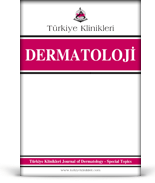Amaç: Kemoterapiyle indüklenen alopesi, onkoloji hastalarında psikososyal açıdan kanser tedavisinin en yıkıcı bulgularından bir tanesidir. Bu çalışmada, kemoterapiyle indüklenen alopesilerin değerlendirilmesinde videodermoskopik incelemenin yerinin belirlenmesi amaçlanmıştır. Gereç ve Yöntemler: Çalışmaya, kemoterapi alan ve klinik inceleme sonrası kemoterapiyle indüklenen alopesi tanısı konan ardışık 41 hasta dâhil edildi. Hastaların yaş, cinsiyet, deri fototipi, malignite tanısı, tedavi protokolündeki kemoterapi ajanları ve alopesinin yaygınlığı kaydedildi. Trikoskopik fotoğraflar X30-X50'lik büyütmeler ile elde edildi. Literatürdeki yayınlar ile oluşturulan kontrol listesine göre trikoskopik bulgular incelendi. Bulgular: Foliküler bulgulardan olan saç çapı değişkenliği hastaların tümünde saptandı. Siyah nokta %78, sarı nokta %75,6, kırık saç %51,2, Pohl-Pinkus %46,3, ünlem işareti saçlar ve alev figürleri %26,8 oranında izlendi. İki renkli, kısa vellus ve moniletrix-benzeri saçlar %22, domuz kuyruğu ve incelen saç %19,5, lale saç %14,6 ve zig zag saç ise %9,8 oranında görüldü. Daha nadir izlenen diğer bulgular V saç %7,3, virgül saç, peripilar bulgu ve boş folikül ise %4,9 oranında idi. Nötrofil benzeri saç (%7,3) ilk kez tanımlandı. Sonuç: Kemoterapi ile indüklenen alopesilerde zig zag saç, lale saç ve V saç yeni trikoskopik bulgulardı. Nötrofil benzeri saçlar ise ilk kez bu çalışmada tanımlandı. Kemoterapiyle indüklenen alopesilerin dermoskopisi, alopesi areata ve trikotillomani ile bazı benzer bulgular göstermektedir.
Anahtar Kelimeler: Alopesi; dermoskopi; kemoterapi; kemoterapi ile indüklenen alopesi; trikoskopi; videodermoskopi
Objective: Chemotherapy induced alopecia is one of the most devastating findings of cancer treatment for oncology patients psychologically. In this study, we aimed to investigate the significance of videodermoscopic features of chemotherapy induced alopecia. Material and Methods: Fourty-one patients, who were treated with chemotherapy and were diagnosed as chemotherapy induced alopecia after clinical evaluation, were included. The age, gender, skin phototype, diagnosis of malignancy, chemotherapy agents in the treatment protocol, location of the alopecia and the severity of alopecia were recorded. Trichoscopic photos were held in X30-X50 fold magnifications. All of the trichoscopic findings were examined in accordance with the checklist which was described by the features of the previous publications. Results: Hair diameter diversity were detected in all of the patients as a follicular feature. Black dots were established in 78%, yellow dots in 75.6%, broken hairs in 51.2%, Pohl-Pinkus in 46.3%, exclamation mark hairs and flame figures in 26.8% of the patients. Bicoulored, short vellus and moniletrix-like hairs were detected in 22%, pigtail and tapering hairs in 19.5%, tulip hairs in 14.6% and zigzag hairs in 9.8% of the patients. V hairs in 7.3%, comma hairs, peripilar finding and empty follicles were established in 4.9% of the patients as other rare findings. Neutrophil like hairs were detected in 7.3% of the patients for the first time. Conclusion: Zigzag hair, tulip hair and V hair were the new trichoscopy findings in chemotherapy induced alopecia. Neutrophil like hairs were defined for the first time in this study. Dermoscopic features of chemotherapy induced alopecia indicates some similar findings for alopecia areata and trichotillomania.
Keywords: Alopecia; dermoscopy; chemotherapy; chemotherapy induced alopecia; trichoscopy; videodermoscopy
- Chon SY, Champion RW, Geddes ER, Rashid RM. Chemotherapy-induced alopecia. J Am Acad Dermatol. 2012;67(1):e37-47. [Crossref] [PubMed]
- Balagula Y, Rosen ST, Lacouture ME. The emergence of supportive oncodermatology. The study of dermatologic events to cancer therapies. J Am Acad Dermatol. 2011;65(3):624-35. [Crossref] [PubMed]
- Rossi A, Caterina Fortuna M, Caro G, Cardone M, Garelli V, Grassi S, et al. Monitoring chemotherapy-induced alopecia with trichoscopy. J Cosmet Dermatol. 2019;18(2):575-80. [Crossref] [PubMed]
- Trüeb RM. Chemotherapy-induced alopecia. Semin Cut Med Surg. 2009;28(1):11-4. [Crossref] [PubMed]
- Tosti A, Piraccini BM, Vincenzi C, Misciali C. Permanent alopecia after busulfan chemotherapy. Br J Dermatol. 2005;152(5):1056-8. [Crossref] [PubMed]
- Miteva M, Misciali C, Fanti PA, Vincenzi C, Romanelli P, Tosti A. Permanent alopecia after systemic chemotherapy: a clinicopathologic study of 10 cases. Am J Dermatopathol. 2011;33(4):345-50. [Crossref] [PubMed]
- Karadağ Köse Ö, Güleç AT. Clinical evaluation of alopecias using a handheld dermatoscope. J Am Acad Dermatol. 2012;67(2):206-14. [Crossref] [PubMed]
- Karadağ Köse Ö, Güleç AT. [Evaluation of treatment response by using a handheld dermoscope in patients with alopecia areata]. Turk J Dermatol. 2018;12:143-8. [Crossref]
- Miteva M, Tosti A. Flame hair. Skin Appendage Disord. 2015;1(2):105-9. [Crossref] [PubMed] [PMC]
- Botchkarev VA. Molecular mechanisms of chemotherapy-induced hair loss. J Invest Dermatol Symp Proc. 2003;8(1):72-5. [Crossref] [PubMed]
- Belum VR, Marulanda K, Ensslin C, Gorley C, Parikh T, Wu S, et al. Alopecia in patients treated with molecularly targeted anticancer therapies. Ann Oncol. 2015;26(12):2496-502. [Crossref] [PubMed] [PMC]
- Karadağ Köse Ö, Güleç AT. Evaluation of a handheld dermatoscope in clinical diagnosis of primary cicatricial alopecias. Dermatol Ther (Heidelb). 2019;9(3):525-35. [Crossref] [PubMed] [PMC]
- Pirmez R, Pi-eiro-Maceira J, Sodré CT. Exclamation marks and other trichoscopic signs of chemothearpy-induced alopecia. Australas J Dermatol. 2013;54(2):129-32. [Crossref] [PubMed]
- Kowalska-Oledzka E, Slowinska M, Rakowska A, Czuwara J, Sicinska J, Olszewska M, et al. 'Black dots' seen under trichoscopy are not specific for alopecia areata. Clin Exp Dermatol. 2012;37(6):615-9. [Crossref] [PubMed]
- Franceschini C, Garelli V, Persechino F, Sperduti I, Caro G, Rossi A, et al. Dermoscopy and confocal miscroscopy for different chemotherapy-induced alopecia (CIA) phases characterization: Preliminary study. Skin Res Technol. 2019 Sep 26. Doi: 10.1111/srt.12970. [Epub ahead of print]. [Crossref] [PubMed]
- Rudnicka L, Rakowska A, Kurzeja M, Olszewska M. Hair shafts in trichoscopy. Dermatol Clin. 2013;31(4):695-708. [Crossref] [PubMed]
- Rossi A, Fortuna MC, Caro G, Pigliacelli F, D'Arino A, Carlesimo M. Chemotherapy induced alopecia: a novel observation. Australas J Dermatol. 2019;60(1):e61-2. [Crossref] [PubMed]
- Rakowska A, Slowinska M, Olszewska M, Rudnicka L. New trichoscopy findings in trichotillomania: Flame hairs, V-sign, hook hairs, hair powder, tulip hairs. Acta Derm Venereol. 2014;94(3):303-6. [Crossref] [PubMed]
- Haider M, Hamadah I, Almutawa A. Radiation- and chemotherapy-induced permanent alopecia: case series. J Cutan Med Surg. 2013;17(1):55-61. [Crossref] [PubMed]







.: Process List